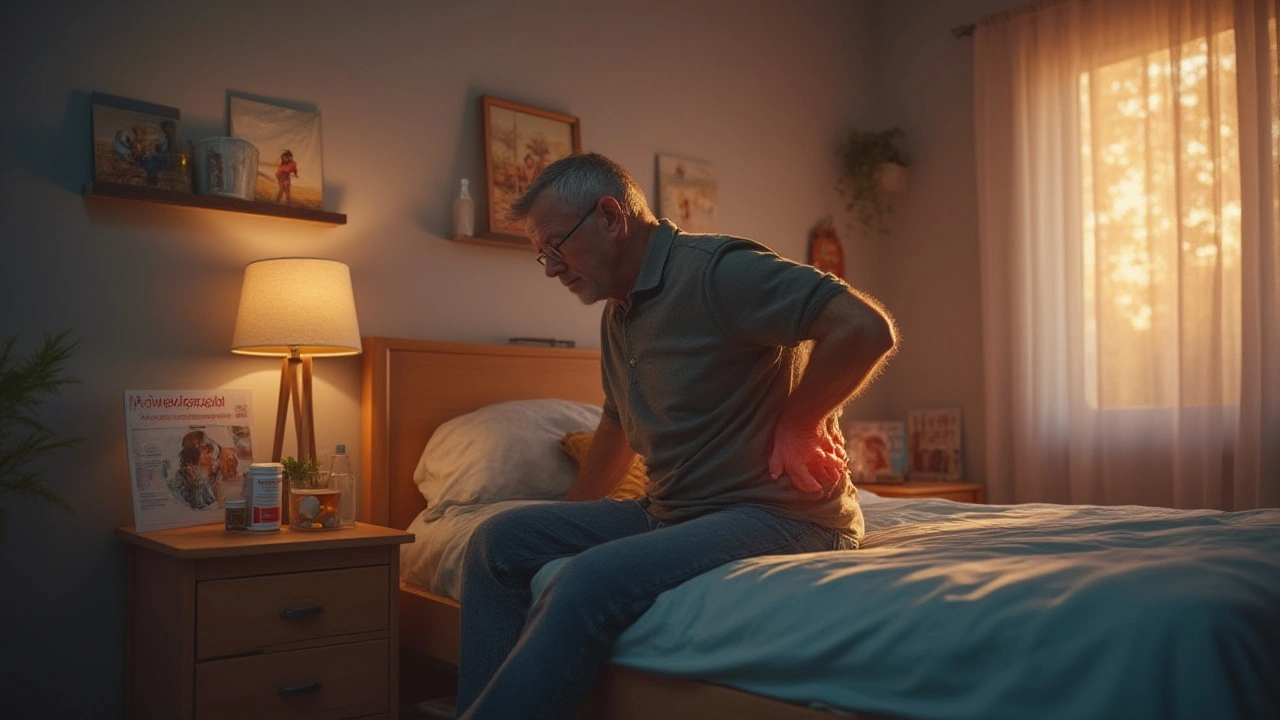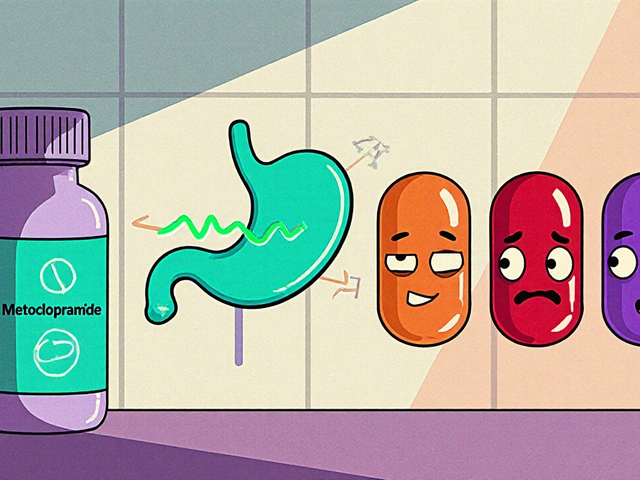If you’ve ever bent down for a sock and suddenly gotten stuck in that all-too-familiar half-crouch, you know back pain does not mess around. Methocarbamol can be a lifeline during those first few days—the kind of pain that makes sneezing feel like a gym accident. But here’s the truth: Not every back spasm is going to bow down to a muscle relaxant, even a proven one. At what point should you stop gritting your teeth and start making more noise with your doctor?
When Methocarbamol Seems to Hit a Wall
Let’s talk brass tacks about methocarbamol. It’s one of the longer-trusted muscle relaxants. If you’ve read up on methocarbamol for lower back pain, you’ll find loads of personal stories, and even a clinical trial out of the UK showing it can speed up pain recovery for muscle spasms. Usually, it’s handed out for “soft tissue” back pain—stuff like pulled muscles, tension, or sitting weird for too long. Most people get relief inside a week. But about 1 in 5 folks in some studies report that it barely takes the edge off, or it stops working after a few days.
Your experience might go like this: three days on methocarbamol and paracetamol, hot pads every night, but pain still throbs deep in your back, and you can’t bend or sleep comfortably. This is where things get tricky. Is it just patience, or a sign to move on? Doctors usually look for progress by day 5, sometimes a bit longer if your pain started mild. If you find that your pain is as bad as it was at the start, or you actually feel worse after a week, it’s a warning that simple muscle relaxants won’t be enough.
Another clue is function: if you still can’t walk, sit, or sleep without pain after 7 days, your doctor will start thinking about escalation. They’ll ask about numbness, weakness, or pain shooting down your legs. If you’re doubling (or tripling) your painkillers with no respectable effect, that’s a red flag for a new approach. Methocarbamol is not addictive, but over weeks it can make you drowsy and sluggish, so nobody wants you on it for long. If your life still feels impossibly limited after a week, it’s time to talk upgrades—not just grit.
Red-Flag Symptoms: When Pain Means Trouble
You've probably heard the phrase "red flag," but in medicine, red flags mean warning signs that pain is doing something sinister behind the scenes. Spotting these early can be life-saving. Start with one unforgettable symptom: pain that wakes you up and gets worse at night. That’s not just a pulled muscle—that should get your antenna up. If back pain teams up with new numbness or tingling that creeps down your legs (or worse, into your groin), doctors worry about nerve roots getting squeezed—possibly by a herniated disc or spinal compression.
Take this seriously: If you notice weakness in your legs (feet flopping, suddenly tripping, or not being able to lift your foot), it means something’s pressing on the nerves that control movement. It gets scarier if you lose bladder or bowel control. I was once in A&E in Bristol when a man came in with exactly that, and let’s just say, he saw a spinal surgeon within two hours. Any loss of function like this points to what doctors call “cauda equina syndrome”—it needs evaluated now, not tomorrow.
| Symptom | Possible Meaning | What to Do |
|---|---|---|
| Constant night pain | Infection or Tumor | See a doctor immediately |
| Shooting pain down one/both legs | Nerve compression | Urgent medical review |
| Numbness in groin area | Cauda equina syndrome | Go to hospital now |
| Difficulty with bladder/bowel | Spinal cord involvement | Emergency attention |
| Fever with back pain | Possible infection | Quick medical assessment |
Red flags aren’t common, but they matter—about 0.7% of back pain cases have a sinister cause behind them, according to NHS figures. But if you have fevers, unexplained weight loss, or a history of cancer, and your back pain is stubborn, you are in the group where we stop talking about rest-and-recovery.

What Happens After Methocarbamol: Next-Line Treatments That Get Results
So, you’ve done everything right: rest, heat, short-term muscle relaxants, maybe even physio, and you still feel like your back is crumbling every time you move. Once methocarbamol has failed, it’s time to level up treatment. The world of next-line solutions is more varied than people think.
For most doctors in the UK, the first escalation is imaging. If you’ve got those red-flag symptoms, you’re off for an MRI. But if your pain is stubborn without scary signs, you might get x-rays or advanced physiotherapy. Corticosteroid injections are where things change for the better for a lot of folks—and not just Olympic athletes. These injections pour potent anti-inflammatories right where your nerves are getting pinched or inflamed. In the UK, about 16,000 spinal corticosteroid injections are done each year, and about 60% of patients report significant pain relief for weeks to months. It’s not a forever solution, but it’s often a golden ticket to get mobility back while your spine sorts itself out.
Some clinics use nerve root blocks, which can be similar but target a single nerve with anaesthetic plus steroid. Physical therapy becomes much more hands-on—manipulation, targeted traction, and sometimes even “pain neuroscience education,” which is a fancy way of saying you learn how pain chemicals work in the brain. My wife, Muriel, once called it “back pain group therapy for nerds”—but it really does help!
Surgery enters the chat only when all else fails: severe nerve compression, constant unrelenting pain, or loss of function. But most people never make it that far. Your average timeline from simple spasm to surgical discussion? About 3-6 months—plenty of time to try all the non-invasive stuff first.
- Short-term opioids if pain is truly disabling and nothing else helps
- Corticosteroid injections—especially for sciatica or nerve root pain
- Multidisciplinary rehab (physio, pain clinics, walking programs, and support)
- Surgery only for critical cases (herniated disc with nerve loss, unstable spine)
Corticosteroid injections aren’t risk-free—they can cause temporary rise in blood sugar and soreness where injected. But for a lot of stubborn back pain, people will tell you it’s the first time they’ve stood up straight in months.
Tips for Surviving the Back Pain Ladder
If you’re out there popping methocarbamol and not feeling close to your old self, don’t just wait and hope. Keep a pain diary where you jot down what works (and when you felt worst). Track symptoms like numbness, weird cramps, and moments you thought you’d drop your groceries. It will help your doctor get to the next step faster.
Get real about your lifestyle, too. Don’t just rest in bed—that’s ancient advice. Gentle walking, swimming, and basic stretches keep things loose so you’re not facing months of stiffness. Don’t forget your mood—persistent back pain is one of the top reasons people lose sleep and get irritable, which then makes pain feel worse. Eat for your spine—foods like salmon, nuts, olive oil, and leafy greens help tamp down the inflammation, more than crisps and takeaways ever will.
If you hit a setback, it’s not the end of the road. Chat honestly with your doc about what you’ve tried. Don’t minimize new symptoms or play tough. Most GPs in Bristol see back pain every single day and would rather help earlier than try to fix things after it all blows up.
Last thing—don’t fall for every miracle gadget online. If it feels like snake oil, it probably is. After methocarbamol stops working, the most important thing is to be honest about your pain and symptoms. Treatments exist, but guessing less and talking more with doctors usually leads to the best shots at long-term relief.







Comments
ka modesto
July 24, 2025 AT 00:11 AMMethocarbamol works for some, but I’ve seen too many people ride it into the ground while their sciatica turns into a full-blown nerve hostage situation. If you’re still limping after 7 days, stop waiting for magic. Get an MRI. Your spine doesn’t care how tough you are.
Holly Lowe
July 24, 2025 AT 03:09 AMY’all are acting like back pain is a villain in a Marvel movie and methocarbamol is the first punch. Nah. Sometimes it’s the whole damn Thanos snap. If your legs feel like they’re made of wet cardboard, don’t text your buddy who ‘took a hot bath and felt better.’ Go to the ER. Seriously. Your future self will high-five you.
Chelsey Gonzales
July 24, 2025 AT 04:34 AMi just took methocarbamol for 3 days n still cant pick up my cat 😭 i think its time to talk to my dr but i dont wanna seem like a drama queen
Crystal Markowski
July 26, 2025 AT 01:58 AMChelsey, you’re not a drama queen-you’re someone who’s listening to their body. That’s strength. Methocarbamol isn’t a cure-all, and the fact you noticed it’s not working means you’re already ahead of most people. Write down your symptoms, make the call, and don’t apologize for needing help. Your pain is valid.
MaKayla Ryan
July 26, 2025 AT 08:22 AMWhy do Americans always think a pill fixes everything? In my country, we do physical therapy, massage, and walk. No drugs. No injections. Just movement. You people are weak.
Sarah Khan
July 28, 2025 AT 07:07 AMThe real issue isn’t whether methocarbamol works-it’s whether we’ve built a healthcare system that rewards silence over self-advocacy. We’re taught to endure pain like a virtue. But pain is data. It’s not a test of character. It’s a signal. And when that signal persists past a week, it’s not stubbornness-it’s a system failure. We need to stop glorifying suffering and start honoring the science of recovery.
Bob Stewart
July 30, 2025 AT 00:51 AMRed flag symptoms require immediate evaluation regardless of perceived severity. Night pain, radiculopathy, or bowel/bladder dysfunction are not benign indicators. Delayed intervention in suspected cauda equina syndrome results in irreversible neurological deficit. Urgent neuroimaging is indicated.
Kelly Library Nook
July 31, 2025 AT 17:29 PMLet’s be clear: the 16,000 corticosteroid injections administered annually in the UK are not a cure. They are a bandage on a ruptured artery. The real problem is the overreliance on pharmacological suppression without addressing biomechanical dysfunction, core instability, or sedentary lifestyle. This post romanticizes temporary relief as progress. It is not.
Charity Peters
August 1, 2025 AT 16:25 PMi got a shot last year and it felt like my back turned back on. like, literally. i stood up straight for the first time in months. no joke.
Kelly Yanke Deltener
August 2, 2025 AT 19:37 PMPeople like you who just say 'go to the doctor' are the reason America’s healthcare is broken. You don’t know what it’s like to have insurance deny everything. You don’t know what it’s like to wait six months for a specialist. Just because you can afford a shot doesn’t mean everyone can. Stop acting like it’s that easy.
Sondra Johnson
August 3, 2025 AT 00:32 AMOh honey, I was that person who waited three weeks because I didn’t want to be 'one of those patients.' Then I woke up with my foot dragging. I screamed so loud my neighbor called 911. Turns out: herniated disc, nerve squished like a bug. I got the injection. I’m walking again. Don’t be me. Be the person who calls first.
Faye Woesthuis
August 4, 2025 AT 16:57 PMStop taking muscle relaxants. They’re just sedatives with a fancy name. If you can’t move, you’re lazy. Get up. Stretch. Walk. No doctor needed. This post is dangerous.
Orion Rentals
August 5, 2025 AT 11:19 AMMs. Ryan’s assertion lacks empirical grounding. The clinical literature consistently demonstrates that prolonged inactivity exacerbates musculoskeletal deconditioning, which in turn amplifies pain perception. Pharmacological intervention, when appropriately timed and monitored, serves as a bridge to functional rehabilitation-not an end in itself. Dismissing evidence-based care as sedation is both medically inaccurate and ethically irresponsible.
Simran Mishra
August 6, 2025 AT 16:09 PMI remember when I first couldn’t tie my shoes, I cried in the bathroom for twenty minutes because I thought I was broken. I didn’t tell anyone for a week. I thought if I just rested more, it would go away. But the pain didn’t care about my silence. It just got louder. I finally went to the doctor and they said, ‘Your spine is screaming, and you’ve been muffling it with hope.’ I got an MRI, then an injection, then a physiotherapist who made me laugh while I did squats against a wall. I’m not fixed. But I’m moving. And that’s enough for today. You’re not weak for needing help. You’re brave for asking.